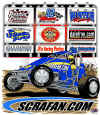


|
Traditional Sprint Car FanSite |
See You At The Races!!! |
| COPPER
WORLD CLASSIC, THE 2003 VERSION by Norm Bogan |
|
|
|
For twenty-six years, the Copper World Classic has greeted many of the snowbirds that journeyed to the Valley of the Sun to escape the bitter winter weather in the heartland of the country. This event has changed its format over the years, first spotlighting the open wheel classes of Midgets, Super-Modifieds and Sprints, which were eventually replaced later by Silver Crown racers along with a field of stock cars from the Western States, later represented by the NASCAR Southwest Tour cars. The Copper World Classic usually took place around the second week in February, but after committing to be a venue for the Indy Racing League, it was decided to make Copper World an all open-wheel event, with the date being shifted to the March schedule for the IRL, with the original February date going to an all stock car format, encompassing the Southwest Tour cars with the Winston West racers. IRL has been struggling with small crowds and it was hoped that the merger with other open wheel classes from a long established program might be beneficial to increased attendance. The original premise of the IRL was to provide an opportunity for many of the Saturday night open wheel racers to attain rides at the highest level. This meant that many of the Midget and Silver Crown drivers could showcase their skills, hopefully gaining a position with an IRL team, just as it was in the 1940s, 50s and 60s. In those years, racers not only ran at Indy but also pursued the Championship Trail, by racing at many fairgrounds dirt tracks throughout the country. Car Owners wanted proven drivers, who could endure a hundred miles of fighting a bucking bronco on a rutted dirt oval. With a second division added to the IRL program this year, the Super-Modifieds, long a staple with the Copper World Classic was deleted. The recent down turn in the economy was evident as the field of cars was down from previous years with only twenty-nine Midgets entered and fifteen Infiniti Pro Series cars for this new division. The IRL had twenty-three entries and the popular Silver Crown division presented a representative fifty-three qualified cars. Saturday saw the Midgets and Infiniti Pros conducting their shows. The USAC Midget Main event found one of the “Davids” in the field gaining the advantage over the Goliath “Super Team of Steve Lewis #9 cars and the dominant Mopar of Dave Steele. Troy, Ohio’s Aaron Pollock qualified his Esslinger powered Drinan in the fourteenth starting position and drove to victory over the more popular Beast Chassis with Pink Ford or Mopar power plants. London, England’s Mark Taylor, a rookie driver for the Panther Racing team, raced to his second victory in two races. Starting from the pole, Taylor led all one hundred laps. Additional teams in this series could improve the competition, while affording many aspiring drivers some seat time in rear engine cars as a stepping-stone to an IRL ride. More of the IRL organizations are likely to develop one of these satellite teams as a proving ground for future drivers. Sunday was the day for the featured events with the 100-mile Silver Crown race followed by the 200-mile IRL show. The Silver Crown race provided some good dicing throughout the field and was punctuated by several crashes and mechanical failures. Front row starters Dave Steele and J.J. Yeley each lead twice, with Steele being the dominant car today and claiming the victory. Tracy Hines finished second with Dave Darland in the show position. Indy Racing League has added a number of quality teams and drivers that have crossed over from the CART ranks. The two new engine programs of Toyota and Honda show a strong challenge to the dominant Chevrolet of the past couple of years. The IRL has raised the bar for most competitors this year, but the casualty is that some of the lesser-financed teams are unable to compete on the full schedule. Hopefully, as the economy recovers, sponsorship monies will become more plentiful and allow these low-buck teams to return to racing. The IRL show was a Tony Kanaan benefit. Tony set the fast time in qualifying, started on the pole and led the most laps winning the race. Helio Castroneves was the runner-up, with Felipe Giaffone, a close third. The top three drivers were all former Brazilian Go-Kart racers, who have been competing against each other since 1986 While the crowd looked sparse early in the day, by the time for the start of the IRL show, the stands filled in with a very representative attendance. This was an encouraging sign for the IRL, since the attendance at many of last year’s shows had been short, but a number of exciting races with close finishes have generated more interest this season. Phoenix International Raceway (PIR) is looking to improve the racing surface during the coming year. The dogleg currently coming out of turn two, will be removed and the track will become a long sweeping turn, allowing the cars to accelerate out of turn one all the way into turn three. With increased banking in this new area, it should allow more high-speed side-by-side racing both in the open wheel and stock cars. The Raceway staff is looking at several new concepts to improve conditions for both the fans and the competitors. |
